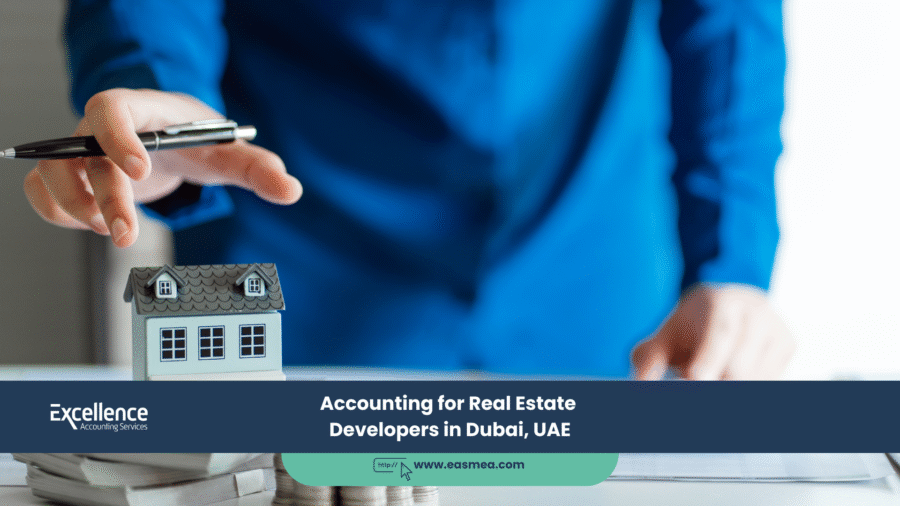Accounting for Real Estate Developers: Applying Corporate Tax Business Restructuring Relief during a Merger
Dubai’s real estate market is characterized by large-scale projects and dynamic corporate structures. Mergers and acquisitions are common strategies for developers looking to consolidate land banks, achieve economies of scale, and strengthen their market position. However, the transfer of high-value assets like land and buildings during such restructuring can trigger significant tax liabilities under the new UAE Corporate Tax regime.
- Accounting for Real Estate Developers: Applying Corporate Tax Business Restructuring Relief during a Merger
- Understanding Business Restructuring Relief in the UAE
- Core Accounting Principles for a Tax-Neutral Merger
- What Excellence Accounting Services (EAS) Can Offer
- Frequently Asked Questions (FAQs)
- Consolidate with Confidence.
Fortunately, the UAE Corporate Tax law provides a crucial mechanism to facilitate such strategic moves: Business Restructuring Relief. This relief allows for the tax-neutral transfer of assets and liabilities during mergers and other reorganizations, preventing an immediate tax burden on unrealized gains. For real estate developers, understanding and correctly applying this relief is not just an accounting task; it’s a critical component of corporate strategy.
This guide provides a detailed analysis of how real estate developers can apply for and account for Business Restructuring Relief during a merger, ensuring a smooth, compliant, and tax-efficient transaction.
Key Takeaways
- Tax-Neutral Transfers: Business Restructuring Relief allows a merger to proceed without triggering an immediate Corporate Tax liability on the appreciated value of transferred real estate assets.
- Assets Transfer at Net Book Value: For tax purposes, assets and liabilities are transferred at their existing net book value, meaning no gain or loss is recognized by the transferring company.
- Strict Conditions Apply: Both companies must be UAE residents, have the same owners, and the ownership structure must remain unchanged for three years post-merger to retain the relief.
- Tax Basis is Carried Over: The acquiring company inherits the original tax basis (net book value) of the assets, not their market value. This impacts the tax implications of any future sale of those assets.
- Thorough Due Diligence is Essential: Before a merger, comprehensive financial and tax due diligence is required to verify asset valuations and ensure all conditions for the relief are met.
Understanding Business Restructuring Relief in the UAE
Introduced under Article 27 of the Corporate Tax Law, Business Restructuring Relief is designed to ensure that tax does not become an obstacle to commercially sensible reorganizations. As per the Ministry of Finance guidelines, this relief allows for a “tax-neutral” transfer, meaning the transaction itself does not create a taxable event.
For a real estate developer, this is immensely powerful. Imagine Developer A is merging with Developer B. Developer A owns a land bank purchased for AED 100 million, which is now worth AED 300 million. Without the relief, transferring this land to the new merged entity could trigger Corporate Tax on the AED 200 million unrealized gain. With the relief, the land is transferred for tax purposes at its book value of AED 100 million, deferring the tax liability until the land is eventually sold to a third party.
Core Accounting Principles for a Tax-Neutral Merger
The accounting for a merger under this relief requires precision and a deep understanding of tax principles.
1. The Transfer of Assets and Liabilities
The central principle is the valuation at which assets are transferred between the merging entities.
- Accounting vs. Tax Treatment: For financial reporting purposes (IFRS), assets in a merger are typically recorded at their fair market value. However, for tax purposes under the relief, they are transferred at their net book value. Your accounting system must be able to track both values.
- No Gain or Loss Recognition: The transferring company (the one being acquired) does not recognize any gain or loss on the disposal of its assets for tax purposes.
- Carryover of Tax Basis: The new, merged company (the acquirer) records the assets on its tax books at the same net book value they had in the old company. This is a “carryover basis.”
The relief doesn’t eliminate the tax; it defers it. The acquiring company inherits the latent tax liability embedded in the assets’ appreciated value.
2. Meeting the Stringent Conditions
To qualify for and retain the relief, several strict conditions must be met:
- The transfer must be part of a qualifying reorganization or restructuring.
- Both the transferor and transferee must be UAE resident persons.
- The owners of the transferor and transferee must be the same before and after the restructuring.
- Crucially, for three years following the merger, the ownership structure must remain the same, and the transferred assets cannot be sold to an outside party. Breaking this condition can lead to a clawback of the tax relief.
A comprehensive business valuation is often a precursor to such mergers to establish fair values, even if they are not used for the tax transfer.
3. Impact on Future Transactions
The accounting decisions made during the merger have long-term consequences.
- Calculating Future Gains: When the merged company eventually sells a transferred property, the taxable gain is calculated as: Sale Price – Original Net Book Value (the carryover basis).
- Example: The merged entity sells the land (from our earlier example) for AED 350 million. The taxable gain is not AED 50 million (350M – 300M market value). The taxable gain is AED 250 million (350M – 100M carryover tax basis).
| Transaction Step | Accounting Treatment (Without Relief) | Tax Treatment (With Relief) |
|---|---|---|
| Land Transfer | Developer A recognizes a gain of AED 200M (300M market value – 100M book value). | No gain or loss is recognized. The asset is transferred at its book value of AED 100M. |
| Immediate Tax Impact | Developer A faces a potential Corporate Tax liability on the AED 200M gain. | Zero immediate tax liability from the transfer. |
| New Co.’s Asset Basis | The merged company records the land at its fair market value of AED 300M. | The merged company records the land at its carryover tax basis of AED 100M. |
| Future Sale at AED 350M | Taxable gain is AED 50M (350M sale price – 300M basis). | Taxable gain is AED 250M (350M sale price – 100M basis). |
What Excellence Accounting Services (EAS) Can Offer
Navigating a merger and applying for tax reliefs requires expert financial and legal guidance. At Excellence Accounting Services, we provide end-to-end support for real estate developers.
- Transaction Advisory: We provide comprehensive business consultancy and advisory services throughout the merger process.
- Due Diligence: Our team conducts thorough financial and tax due diligence to identify risks and ensure all conditions for the relief are met.
- Corporate Tax Planning: We specialize in UAE Corporate Tax, helping you structure the merger for maximum tax efficiency and ensuring full compliance with the relief conditions.
- System Integration: Post-merger, we can assist with accounting system implementation to integrate the financials of the two entities seamlessly.
- Valuation Services: Our business valuation services establish the fair market value of assets, which is crucial for financial reporting and strategic decision-making.
Frequently Asked Questions (FAQs)
No. The Business Restructuring Relief applies specifically to UAE Corporate Tax. It does not provide relief from other fees, such as the DLD’s 4% transfer fee, which would likely still be applicable based on the property’s market value.
The clawback provision applies on an asset-by-asset basis. If you sell one of the transferred assets within three years, the relief for that specific asset is revoked. The original transferring company would have to go back and recognize the gain from the time of the merger, potentially incurring tax and penalties.
Yes, the relief is designed for various types of reorganizations, including mergers, demergers, and spin-offs, as long as the underlying conditions (UAE residency, common ownership, etc.) are met.
The acquiring company continues to depreciate the building for tax purposes based on its original carryover tax basis and remaining useful life, not on its higher fair market value.
It applies to both. The shareholders of the merged entity cannot change significantly, and the specific assets transferred under the relief cannot be disposed of to a third party during this period.
Yes. The condition is that the “persons” who own the entities are the same. This can include natural persons (individuals) as well as juridical persons (companies).
Yes, you must make an application to the Federal Tax Authority (FTA) to avail of the relief. The FTA will review the transaction to ensure all conditions are met. This is not an automatic relief.
The UAE Corporate Tax law has separate, complex provisions for the transfer of tax losses during a merger. The transfer of losses is not automatic and is subject to its own set of conditions, which should be evaluated separately from the Business Restructuring Relief for assets.
Yes. For your published financial statements, you would typically follow IFRS 3 (Business Combinations), which requires recording assets at fair value. You would then maintain a separate set of records for tax purposes showing the assets at their carryover basis. This creates a “book-tax difference” that needs to be managed by your accounting team.
This requires a robust fixed asset register and internal controls. The register must clearly tag all assets transferred under the relief and include the date of the merger. Your legal and compliance teams must have a process to check this register before any asset sale is approved. A failure in this internal audit process could be very costly.
Conclusion: Building a Tax-Efficient Future
For real estate developers in the UAE, Business Restructuring Relief is a powerful tool that enables strategic growth without incurring immediate, prohibitive tax costs. However, its application requires meticulous planning, expert legal and tax advice, and a robust accounting framework to manage the long-term implications. By navigating these complexities correctly, developers can consolidate their operations, enhance their market position, and build a more efficient and profitable future.
Consolidate with Confidence.
Let Excellence Accounting Services guide you through the complexities of UAE Corporate Tax Relief, ensuring your real estate merger is built on a solid financial foundation.




